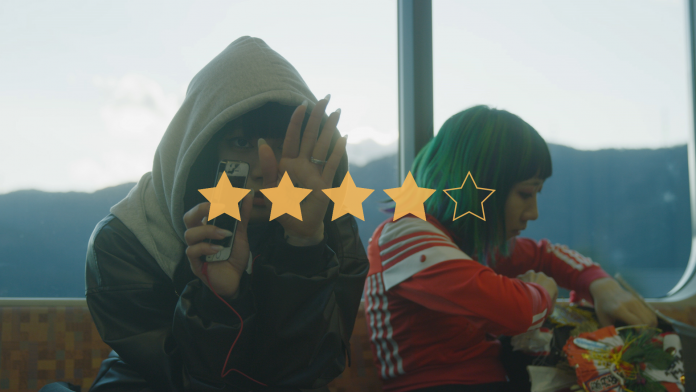Philippe McKie’s first feature film and Japan’s first ever urban dance film is a visually electrifying and thematically layered take on the universal ‘struggling artist’ trope. Dreams on Fire captures the fierce beauty of Tokyo’s urban dance scene whilst shining a light on the sinister underbelly of the city’s entertainment industry.
★★★★✰
The film follows Yume (Bambi Naka), an aspiring dancer who moves from her small rural town to Tokyo after having an explosive argument with her father. Feeling like “a small fish in a big ocean,” Yume navigates through the dark depths of the city where she encounters financial hardship, constant audition rejections, and exploitation at her new job at a hostess club in Tokyo’s red light district. Yet, despite the typical individualist approach used in ‘struggling artist’ stories, Yume’s struggles are alleviated by the blossomed friendships she forms along the way.
The film begins with a rapid pace, cutting from a captivating contemporary dance set with an entrancing soundtrack to an underground dance battle with pulsating electronic music. The first time we see Yume dance in the battle scene is nothing short of mesmerising, not just because of her dance ability but for her acting too. Bambi Naka’s performance is one of the film’s greatest strengths. Almost like being under a hypnotic charm, it’s impossible to steer your eyes away from Naka and her entrancing ability to transform from a timid and reserved young woman to assertive and radiating with a burning desire when she dances. Each scene is as alluring as the next, leaving little time to catch your breath as the character development and emotion of Yume is presented through the whiplash-inducing transitions between sets.
On a technical level, Dreams on Fire is sublime. The camera work and enclosed spaces are manipulated to convey Yume feeling restricted and suffocated by constant rejections. Cinematographer James Latimer captures the allure of Tokyo’s talented creatives through a bold, mystical colour palette that mirrors the atmosphere of the lustrous city. The visual aesthetic complements each of the performers we see, pulling our gaze closer to the screen, following every movement and contour of the dancers’ bodies. Dreams on Fire features performances from the number one go-go dancer crew in Japan, CyberJapan, and top drum and bass artist DJ AKI. They throw themselves into an immersive portrayal of the city’s underground dance scene, setting the bar sky-high for any future dance films.
Behind the ethereal and dreamlike aura that radiates on screen are the very real and important issues that underpin the struggles that Yume and many women face every day. Drowning in the concrete abyss of the city, Yume struggles to keep afloat, so she seeks out work at a hostess club. The intimidating and persuasive boss (Masahiro Takashima) offers Yume a job on the one condition that she wears a school girl costume and changes her makeup to appear ‘sexier,’ deceiving Yume into thinking that the paying male customers want only platonic company for the night. Paralleling the discrepancies between Yume in absolute control of her body when dancing with scenes showing men touching Yume without her consent, McKie handles the deeply complex themes of sex work and objectification of women with authenticity and care. Without empowering the exploitation of workers, Dreams on Fire highlights the resilience of Yume and women globally whilst critiquing capitalist systems that allow the commodification of women.
A refreshing and hopeful aspect of the narrative derives from the onscreen relationships Yume forms with other women, bonded by the mutual understanding each of the women has for one another living under a patriarchal society. Subverting the typical trope seen in struggling artist films like Whiplash, Dreams on Fire rejects the idea that abandoning people in your life is necessary to focus on your goals. Instead, McKie tells Yume’s story of struggle through a collectivist lens, conveying the importance of friendship when trying to navigate a ruthless and cut-throat world.
The film’s flaw lies in the ambitious two-hour runtime. Tokyo’s ‘city that never sleeps’ mentality is mirrored in the film’s rapid pacing, showcasing every inch of Japan’s artistry and talent until it reaches a burnout halfway through. With McKie’s focus on visuals over dialogue, the absence of striking dance and music sets for periods of the film causes the narrative to feel lost and unfocused for a short while. That being said, the reignition of the story with its climactic resolution compensates for a middle sequence stuck in something of a limbo.
The Verdict
Whilst the film’s premise is a familiar framework in cinema, Dreams on Fire is a unique retelling of a classic story. Its striking visuals and captivating choreography will leave you craving a rewatch to absorb every ounce of the film’s aesthetic allure. With McKie’s experimental and candid style shooting balanced with meticulous, detailed editing, Dreams on Fire is an intimate and visceral viewing experience that immerses the audience into Yume’s journey.
Dreams on Fire was screened as part of the Fantasia Film Festival 2021.
Words by Alexandria Slater
Support The Indiependent
We’re trying to raise £200 a month to help cover our operational costs. This includes our ‘Writer of the Month’ awards, where we recognise the amazing work produced by our contributor team. If you’ve enjoyed reading our site, we’d really appreciate it if you could donate to The Indiependent. Whether you can give £1 or £10, you’d be making a huge difference to our small team.
